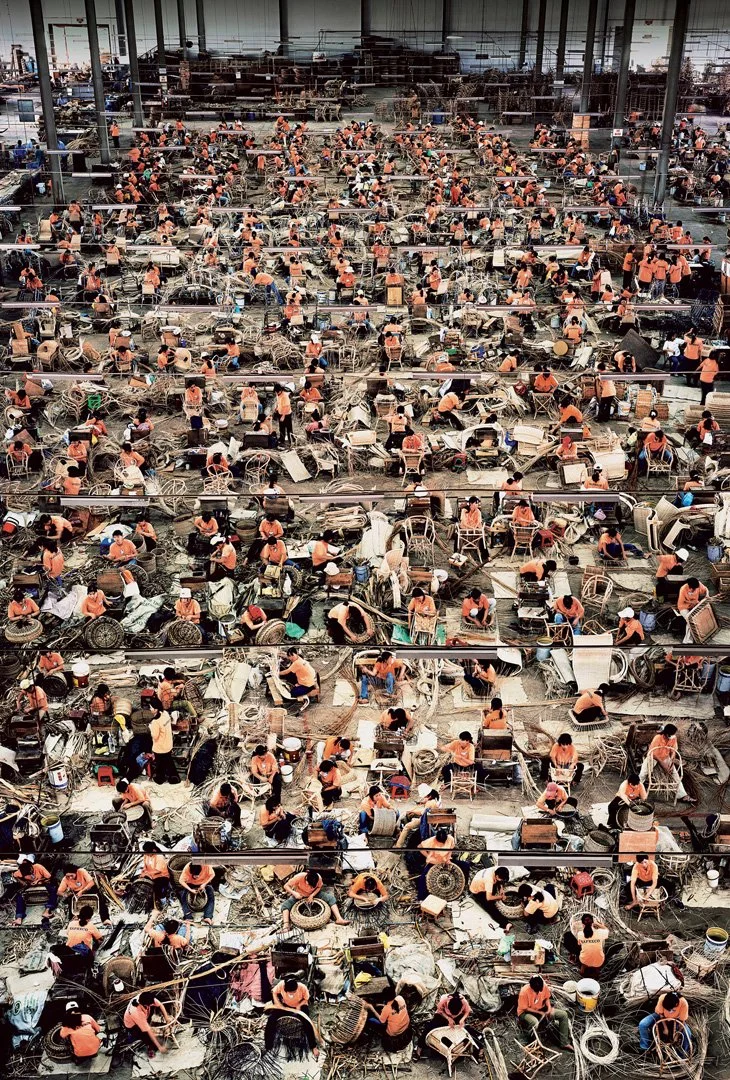ANDREAS GURSKY
Nothing Is As It Initially Appears
Emerging from the renowned Düsseldorf School from the late 80s, Andreas Gursky is known all over the world for creating a new standard in contemporary photography. Today we explore the rise of his popularity.
Gursky pioneered the possibilities of scale by specializing in large format panoramic urban landscape and architectural compositions. Since the 90’s his large scale images have captured the modern world, taking an aim at globalism in EPIC detail.
Born in Leipzig in 1955, he grew up surrounded by a lab and camera equipment- his father owned a photography studio. Originally he was determined not to follow in his father’s footsteps, but eventually ended up getting a photography degree from the Folkwang University of the Arts, in Essen. In 1980 he enrolled at the Düsseldorf Art Academy and was a student of the famous German conceptual photographers Bernd and Hilla Becher. The Bechers, for over nearly 50 years, documented the water towers and industrial architecture of Germany’s Ruhr Valley, shot in black-and-white with rigorously objectivity and displayed in systematic sequences. It was then Gursky started taking color panoramas of mountains and swimming pools featuring very tiny human beings.
A switch to digital photography in the early ’90s allowed him to take large-format photographs and to manipulate the images in digital postproduction — by “pumping up the color sometimes or combining several different images in order to get an even perspective. His work is often shot from what he calls a ‘God’s-eye view and we see that in works like: ‘Tour de France’, and ‘Hong Kong Island’. In order to get this birds eye perspective he shoots from helicopters, cranes and private rooftops. It was his show at the MOMA in 2001 that catapulted his fame and In 2011, his photograph Rhein II sold at Christie's New York for $4.3 million, (it was the most expensive photograph ever sold until this year when Man Ray’s 1924 photo Le Violon d’Ingres sold for $12.3m at a Christie’s sale).
So what makes Gursky one of the most important figures in photography today?
Some say it was all about the timing- His work in the ’90s came at a perfect moment, just as globalization was gathering pace. Gursky represented the spread of multinationals and the explosion of financial markets, as they were striking “the right balance between something that is neither critical nor apologetic.” His work also embodied the shift from analog to digital, from “taking images” to “making images,” said Mr. Bajac former curator at the MOMA.
In addition to his work focusing on social phenomena, consumerism and urban planning, Gursky has been interested in exploring the realities of climate change and our planet. From bodies of water, from the Rhine in Germany to the Chao Phraya in Thailand. The Bangkok series (2011) depicts the littered, surface of this fast-flowing river from close range. For the Ocean works (2010), Gursky sourced high-definition satellite photography to generate his own interpretations of sea and land, constructing scenes of oceanic expanses with coastlines visible at the images’ outermost edges. From environmental threats to growing crowds and infrastructural development, Gursky’s photographs capture the extremity of the times hence the strong interest for collectors in terms of relevancy. Darius Himes, who heads the international photography division at Christie’s remembers the shock of seeing Gursky’s work for the first time—in 2001 at the Museum of Contemporary Art in Chicago. “It’s particularly impressive when you’re used to seeing beautiful prints at 16 by 20 inches,” he says. “Gursky’s work operates at a scale that is completely different from what people are accustomed to. It’s as impressive as looking at a large Barnett Newman painting.”
Since the pandemic he drew inward and began rediscovering the work in his extensive archive. His studio in Düsseldorf and his second home in Ibiza became the locations that sparked his imagination for his most recent work. Unfortunately, a lot of art critics haven’t always been kind towards his body of work, so what do you think?
Unfortunately, Gursky's computer manipulations are so inept that ugliness results.
That MoMA would even consider mounting a retrospective of this overpriced, underdeveloped German shutterbug at such an early point in his career signals a troubling loss of perspective. Tacky corporate guilt and greed rule all in the temple of modernism. The deliberate impersonality of Gursky's efforts also suck an important element from the art experience: intimacy.
- CHARLIE FINCH is co-author of Most Art Sucks: Five Years of Coagula (Smart Art Press).
Review, 2016.
© Andreas Gursky/Artists Rights Society (ARS), New York/VG Bild-Kunst, Bonn
Madonna I presents a nuanced view of a spectacle, both portraying mass entertainment and documenting a historical moment of rupture. Taken on September 13, 2001, the photo shows a Madonna concert that became an impromptu tribute to the victims of the 9/11 terrorist attacks, a communal remembrance of the traumatic event. Here, the musician wears an American flag, and in the lower left corner a monitor displays the Manhattan skyline. With all its sensational elements, however, this depiction of the performance oddly approaches the ordinary, through the structured presentation of orderly rows of stadium seating. In comparison, the true spectacle becomes the impact, both real and symbolic, of the events of 9/11 and their aftermath, so enormous as to be incomprehensible in their entirety. - The Broad





